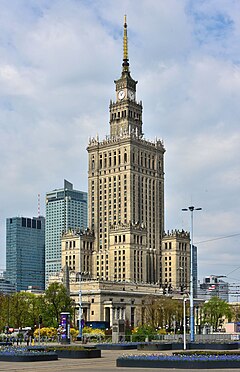
Back Paleis van Kultuur en Wetenskap Afrikaans Palacio d'a Cultura y la Ciencia AN قصر الثقافة والعلوم (وارسو) Arabic قصر الثقافه والعلوم فى وارسو ARZ Mədəniyyət və elm sarayı Azerbaijani Палац культуры і навукі Byelorussian Дворец на културата и науката Bulgarian Palata kulture i nauke BS Palau de la Cultura i la Ciència Catalan Palác kultury a vědy Czech
| Palace of Culture and Science | |
|---|---|
Pałac Kultury i Nauki – PKiN | |
 Palace of Culture and Science in 2019 | |
 | |
| General information | |
| Type | Mixed-use |
| Architectural style | Stalinist |
| Location | Warsaw, |
| Address | Plac Defilad 1 |
| Coordinates | 52°13′54″N 21°00′23″E / 52.23167°N 21.00639°E |
| Construction started | 2 May 1952 |
| Completed | 22 July 1955 |
| Height | |
| Architectural | 237 m (778 ft) |
| Roof | 187.68 m (615.7 ft) |
| Observatory | 114 m (374 ft) |
| Technical details | |
| Floor count | 42 |
| Floor area | 123,084 m2 (1,324,865 sq ft) |
| Design and construction | |
| Architect(s) | Lev Rudnev |
| Other information | |
| Number of rooms | 3288 |
| Public transit access | |
| Website | |
| www | |
The Palace of Culture and Science (Polish: Pałac Kultury i Nauki;[a] abbreviated PKiN)[b] is a notable high-rise building in central Warsaw, Poland. With a total height of 237 metres (778 ft), it is the second tallest building in both Warsaw and Poland (after the Varso Tower), the sixth tallest building in the European Union and one of the tallest on the European continent.[1] At the time of its completion in 1955, the Palace was the eighth tallest building in the world, retaining the position until 1961; it was also briefly the tallest clock tower in the world, from 2000 until the 2002 installation of a clock mechanism on the NTT Docomo Yoyogi Building in Tokyo, Japan.[2]
Motivated by Polish historical architecture and American art deco high-rise buildings, the Palace of Culture and Science was designed by Soviet-Russian architect Lev Rudnev in "Seven Sisters" style.[3]
The Palace houses various public and cultural institutions such as theatres, cinemas, libraries, university faculties and authorities of the Polish Academy of Sciences. Surrounding the building are a collection of sculptures representing figures of the fields of culture and science, with the main entrance featuring sculptures of Polish astronomer Nicolaus Copernicus, by Ludwika Nitschowa, and Polish poet Adam Mickiewicz, by Stanisław Horno-Popławski. Since 2007, the PKiN has been enlisted in the Registry of Objects of Cultural Heritage.[4]
Cite error: There are <ref group=lower-alpha> tags or {{efn}} templates on this page, but the references will not show without a {{reflist|group=lower-alpha}} template or {{notelist}} template (see the help page).
- ^ "Historia Pałacu" [History of the Palace]. Pałac Kultury i Nauki (in Polish). Archived from the original on 22 June 2019. Retrieved 22 March 2016.
- ^ "NTT DoCoMo Yoyogi Building". Emporis. Archived from the original on 12 May 2015. Retrieved 30 July 2022.
- ^ Sorokina, Anna (13 April 2021). "Where outside Russia can you find Stalin's skyscrapers?". Russia Beyond. Archived from the original on 11 January 2022. Retrieved 30 July 2022.
- ^ Kłopotowski, Krzysztof (6 March 2018). "Pałac Kultury w Warszawie. Pomnik Stalina, Wersal Bieruta" (in Polish). Rzeczpospolita. Retrieved 4 June 2023.